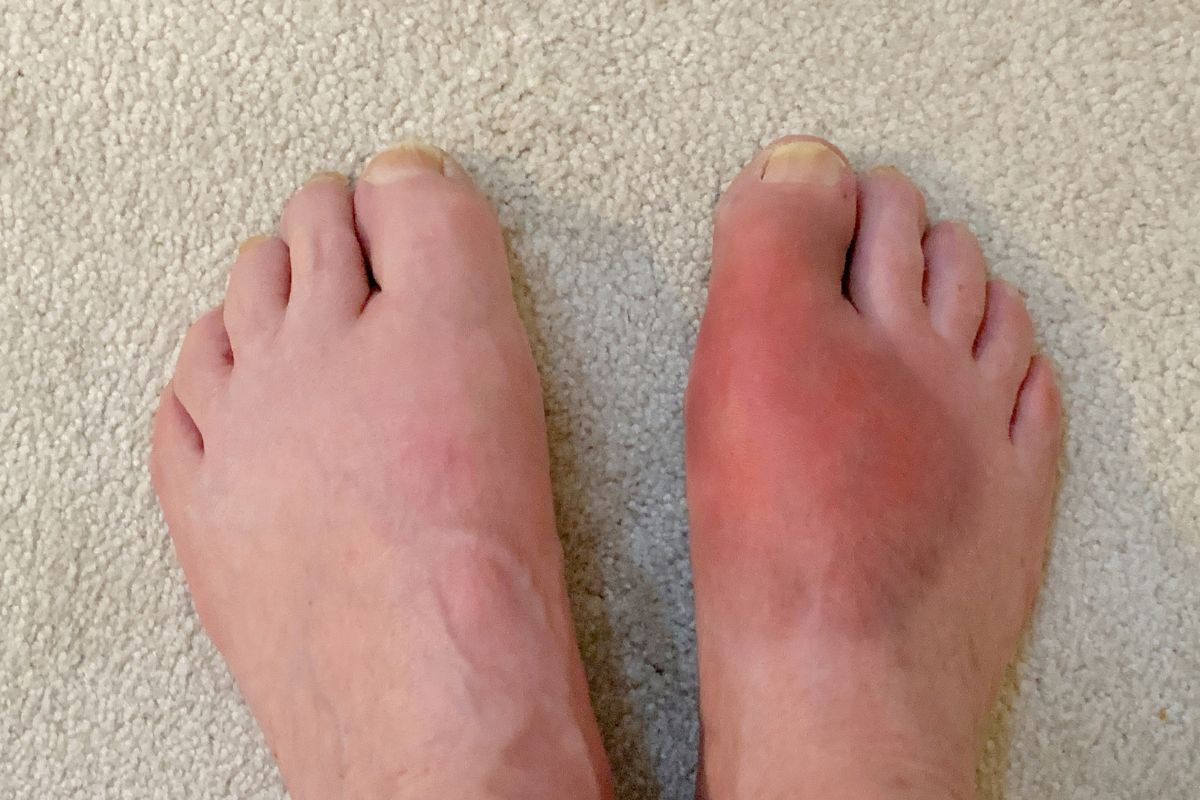Gout is a complex and common medical condition that many people suffer from today. However, thanks to advances in technology and medicine, probenecid is now a common treatment for it.
This medication is used to treat the condition by removing all the extra uric acid within the body.

While there is no known cure for gout, this medication will prevent flare-ups, and help individuals lead relatively normal lives.
To find out more about gout and probenecid, keep reading. Here, we will take a pin-depth look at what gout is, including what causes it, and probenecid.
So, if you’re interested in learning about gout treatment, as well as possible side effects and cautions, stay tuned.
Probenecid Treatment For Gout
Probenecid was first approved to be used in the US in 1951. Since then, it has continued to be used for a variety of medical conditions, including gout and hyperuricemia.
This medication, while effective for long-term use in treating gout, is not without its side effects – especially during initial use.
What Is Gout?
Gout is a type of inflammatory arthritis. It is relatively common, and is known to be a very painful condition, affecting one joint at a time.
The joints that are most commonly impacted include areas like the big toe, knees, and fingers.
Individuals with this condition will experience phases of remission (when there are no symptoms), and phases of flares (when symptoms get noticeably worse).
This type of arthritis can have sudden onset, and cause extreme joint pain, which will impact the quality of daily life. Gout is most common in people between the ages of 30 and 60, but can present itself earlier.
Levels of uric acid will typically be elevated for around 10 to 20 years before the onset of this condition.
For men, puberty is the time when uric acid levels will rise, and the peak age of this condition’s onset is between 40 and 60 years old. Women are more likely to experience gout after going through the menopause.
Symptoms Of Gout
There are a number of gout symptoms that you should look out for, especially if you are in the age range where gout is most common. Symptoms include:
- Severe pain in at least one joint; can be more joints
- The joint feels very tender and hot
- There is noticeable swelling in and around the joint that is impacted
- Shiny, red skin over the impacted joint
The above symptoms will develop very quickly (typically within a few hours), and they will last for anywhere between 3 and 10 days.
After the allocated time has passed, the joint should revert to its usual state. Someone with gout will likely experience another attack within the year, and they will continue to do so without treatment.
The Cause Of Gout
This inflammatory condition is due to a build-up of uric acid present in the blood. When too much uric acid is produced by the kidneys, enough of the substance won’t be filtered out.
This build-up can cause sharp, miniscule crystals to form around and in the joints of your bodies.
The joint will then become inflamed because of these tiny crystals, and it will become incredibly painful.
Risk Factors For Gout

There are a number of health issues and behaviors that have been linked to developing gout. These things include issues such as the ones mentioned below:
- Kidney issues
- Diabetes, high blood pressure, or obesity
- Drinking too much alcohol (such as spirits or beer)
- Having a close relative (such as parent or sibling) who experiences gout
- Eating a lot of foods that will cause a uric acid build-up (such as seafood, offal, and red meat)
Associated Conditions For Untreated Gout
If gout is left untreated, it is common for further health issues to develop because of it.
Below are some common complications that those with gout might experience if they fail to treat their condition:
- Tophi – crystals forming under the skin. Sizes can range from small bumps to larger lumps. This can get serious enough to become chronic, and negatively affect daily life. Most commonly found on the feet and fingers or hands of affected individuals.
- Joint damage – untreated gout can result in permanent damage being done to the joints. In serious cases, surgery may be required, and joins will need to be either repaired or replaced.
- Kidney stones – high levels of uric acid can lead to kidney stones forming. This can interfere with urine flow, and make you feel like you need to pee more frequently. Medication may need to be prescribed to dissolve the stones, and prevent more from forming.
- Emotional and psychological impact – gout is an unpleasant condition that will have a negative impact on home and work life, as well as mood. The pain can make everyday life difficult, and anxiety and depression have a high comorbidity.
What Is Probenecid?
Probenecid is a medication that is used to treat gout and gouty arthritis. It works by increasing the amount of uric acid that gets passed by the urine.
As excess uric acid is the cause of gout, this medication has been proven to be effective as a treatment option.
This medication is typically taken orally, and can be prescribed along with other medications.
A common combination for probenecid is that of penicillin, or a similar antibiotic. This is done to increase the antibiotic levels in the blood.
How Probenecid Treats Gout
This medication treats gout by forcing your body to get rid of the excess uric acid. When the uric acid levels are brought down to a normal level, flare-ups should no longer be an issue.
How Probenecid Is Taken
Probenecid is usually taken orally twice a day, preferably with a meal and a glass of water.
It should only be prescribed to people who are two years or older, though it is rarely needed for young individuals.
When prescribed this medication, your medical practitioner might also advise you on medications to avoid, or dietary or lifestyle changes to improve your symptoms.
The dosage of this medication will depend on how well you respond to the therapy and your overall condition.
Low doses are typically done first, and then it is adjusted based on the symptoms you show and the levels of uric acid.
When you are symptom-free for a number of months and the levels of uric acid in your body are deemed normal, the dose may be lowered.
From there, the lowest effective dose will be prescribed to try and maintain the condition.
Should Probenecid Be Started During A Gout Flare Up?

This medication should never be started during a flare up of gout. Instead, you will need to wait until your current flare up is over before beginning medication.
Although pain can be excruciating, starting medication at these times will not help.
It’s also worth noting that once initially starting on this medication, gout attacks are likely to become more common for the first few months.
This will happen while the medication takes effect, and the extra uric acid is being removed from your body.
As probenecid is not for pain relief, the medication should be accommodated with the usual prescribed medication for the pain. Common options include medications like indomethacin, ibuprofen, or colchicine.
The Possible Side Effects
There are a number of side effects you may experience if you are prescribed probenecid. These symptoms include the following:
- Frequent urination
- Sore gums
- Headaches
- Vomiting
- Dizziness
- Loss of appetite
- Nausea
The majority of people who are on this medication do not experience severe side effects. However, as everyone is different, you may react to medication differently to others.
There are also a number of more severe side effects that you should be on the look out for if you have started this medication.
If you experience any serious side effects, you should seek medical attention immediately. Serious side effects include any of the following:
- Change in the color or amount of urine
- Painful or difficult urination
- Lower back pain
- Easy bleeding or bruising
- Any signs of an infection (such as sore throat or a fever)
- Pale stools
- Dark urine
- Fatigue
- Yellowing skin or eyes
- Severe abdominal pain
- Itching or swelling (especially in places like the throat, tongue, or face)
- Itching
- Rash
- Issues breathing
- Severe dizziness
How Long Does Treatment Last?
Treatment for gout is a continuous process. Once diagnosed and treatment begins, the dose will start high and gradually be lowered depending on how your body reacts to it.
To maintain healthy uric acid levels in the body, the aim is to get you on the lowest effective dose as possible. You will then need to continue taking your probenecid medication daily.
Failure to continue medication will result in more flare-ups as the uric acid levels rise in your body again. Any missed doses should be taken as soon as you remember, but never take a double dose.
If your next dose is due very soon, the missed dose should be skipped. After that, resume with the normal dosing schedule.
Final Thoughts
Gout is a painful but relatively common inflammatory disease. Probenecid is used to treat the condition by removing the excess uric acid from the body.
While this medication is amazing and an ongoing treatment, patients who use it may experience a number of symptoms because of it.
However, symptoms are generally mild. If you do experience any of the severe symptoms listed above, seek medical attention immediately.
- Understanding Male Reproductive Health: A Complete Guide - February 2, 2025
- Simple Healthy Skin Habits for Radiant Skin - December 6, 2024
- Unlocking the Connection Between Nutrition and Mental Health - December 3, 2024








